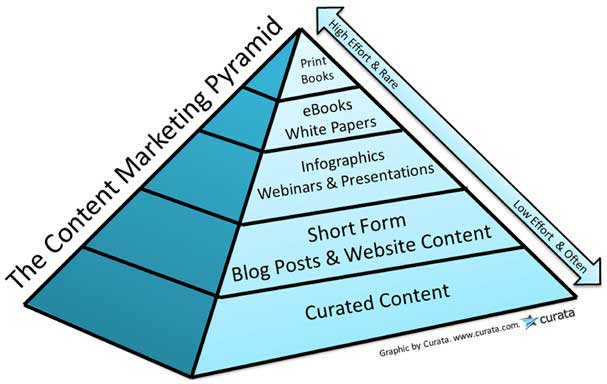As summer approaches, some of us will hit the gym in hopes of being swimsuit-ready. Though dragging ourselves out of bed for a five-mile run before that 9 AM meeting isn't much fun at first, the more we exercise the easier it becomes. That's because we're building up our endurance and creating a habit of early-morning runs.
Content marketing is the same way. When we stretch our creative muscles and get into the habit of producing content, it becomes almost second nature.
Last fall, Curata surveyed more than 450 marketing professionals, including CMOs and VPs of marketing, about the state of B2B marketing. Respondents cited limited budget (27%), limited staff (25%), and creating new content (21%) as their biggest marketing challenges.
Here's the good news: Unlike exercise, where there are no shortcuts outside of sweat and hard work, content marketing does have strategies for making production more efficient, both in terms of time and staff resources.
The Content Marketing Pyramid is a framework for creating a mix of short, low-effort content and longer, more time-intensive content.

The foundation of the pyramid is curated content. Curation means finding, organizing, and sharing relevant online content that provides value for readers and positions your company as an industry authority.
Often, curated content comes from sources other than your own blog or website, and it's an avenue for participating in the larger online community. Some 57%% of respondents to Curata's fall 2012 survey were currently using content curation as part of their content marketing strategy.
Think of content curation like interval training, short bursts of high-intensity exertion that can have bigger payoffs over the long term. Although it takes time to find quality content to share, curation takes relatively low effort compared with creating content from scratch, and it lends itself to high frequencies.
Short-form blog posts, infographics, and e-books form the middle of the pyramid. Think of those as a 5K run. Then, at the top of the pyramid, are longer pieces like whitepapers and print books, which require a lot of time and effort (not unlike running a marathon).
You wouldn't compete in a marathon without first training for months, perhaps with shorter races, and plenty of stretching the morning of the race; similarly, you can use shorter pieces of content, such as blog posts and e-books, to build up stamina for whitepapers and print books.
In fact, those shorter pieces could serve as inspiration or be repurposed for longer pieces. The more you do it, the more you think about an integrated content approach to every piece of content you create. While producing an e-book, you might make mental notes about that how that concept might work as an infographic. You might find a great stat that doesn't fit for your blog post, but would make a great PowerPoint slide for your webinar. With practice, this type of thinking becomes almost instinctual.
The best athletes cross-train to ensure that they're hitting every major muscle group, and your content marketing should be no different. Use a variety of lengths and formats to create a well-rounded content marketing plan.
Here's an example of how to make your content climb the Content Marketing Pyramid:
- First, you might curate content about content marketing and share it through your social media channels—such as Facebook, Twitter, LinkedIn, and Google +—and your email newsletter. Seeing which topics drive the highest engagement (retweets and shares) could offer guidance on what to turn into blog posts.
- Say your social media followers are especially excited about a certain piece of curated content. You can riff on the topic of that content in a series of blog posts and website content for your own site, or for other relevant sites as guest posts.
- So your blog posts are now generating a ton of comments about content marketing, including some questions that you decide to answer in a webinar (as we did). The webinar also helps you generate email signups! During the webinar, you could conduct a poll and gather data for an infographic or e-book.
- Using information gathered through your blog posts and webinar, you could create (again, as we did) an e-book called How to Feed the Content Beast (registration required), targeted at content marketers, providing tips on supplementing their current content with curated content.
- To take things a step further, you could release a print version of the e-book via print-on-demand services like Lulu.com.
We can't literally coach you through a 5K or a marathon, but these strategies will help ensure that your content goes the distance and reaches the figurative finish line.
* * *
Have you repurposed content in different formats and channels? Tell us your strategies for getting more mileage!




